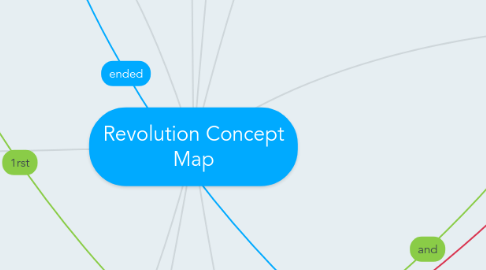
1. Challenging Authority
1.1. The first Great Awakening
1.1.1. influenced religious protection
1.2. The Glorious Revolution
1.2.1. Allowed colonies to do more.
1.2.2. The overthrow of King James II
2. British Policies
2.1. Mercantilism
2.1.1. export more than import
2.2. French and Indian War
2.2.1. Caused the British to tax the Colonists.
2.3. Proclamation of 1763
2.3.1. A line drawn along the Appalachian Mountains
2.3.2. Colonists could not settle West.
2.3.3. After French and Indian war
2.4. Declaratory Act
2.4.1. was an act of Parliament of Great Britian, was at the same time as repeal of stampact, and lessoned the sugar act
2.5. Townshend Acts
2.5.1. was all the acts together.
2.6. Writs of Assistance
2.6.1. Clamped down on smuggling
2.7. Quartering Act
2.7.1. Colonists had to provide food, housing and blankets for British soldiers.
2.8. Tea Act
2.8.1. A tax on tea
2.9. Coercive/Intolerable Acts
2.9.1. After the Boston tea-party- Laws to punishment colonist for the tea party.
3. Rule of Law
3.1. Magna Carta
3.1.1. written by rebel nobles to turn power away from the monarch
3.2. English Bill of Rights
3.2.1. Seperation of Powers
4. British Taxation
4.1. George Grenville
4.1.1. In parliament
4.1.2. British Whig
4.2. Vice Admiralty Court of Halifax
4.2.1. Currency act established it
4.2.2. jurryless court, handeled disputes between seamen and merchants,
4.3. Stamp Act
4.3.1. coming together to fight repression
4.3.2. direct tax
4.3.3. repeal of stampact
4.4. Sugar Act
4.4.1. Colonial merchants were required to pay taxes on sugar
4.4.2. change an lessoning
5. Revolutionary Events
5.1. Boston Massacre
5.1.1. A fight between patriots and British soldiers.
5.2. Seige of Boston
5.3. First Continental Congress
5.3.1. was a colonial reaction to intolerable acts
5.4. Battles of Lexington and Concord
5.4.1. One of the first battles in the American revolution
5.5. Second Continental Congress
5.6. Declaration of Independence
5.6.1. Benjamin Franklin
5.6.2. George Wahsington
5.6.2.1. John Adams
5.6.2.1.1. Vice president
5.7. Common sense
5.7.1. Thomas Paines pamphlet
5.7.2. Inspired the colonies to fight for independence
6. Enlightenment
6.1. Thomas Hobbes
6.1.1. Natural rights
6.2. Jean-Jacques Rousseau
6.2.1. Social Contract
6.2.2. Philosopher
6.2.3. Brought Locke ideas further
6.3. Baron de Montesquieu
6.3.1. 3 types of political power
6.3.1.1. executive
6.3.1.2. legislative
6.3.1.3. judical
6.4. Valitare
6.4.1. freedom of speech
6.5. John Locke
6.5.1. Natural rights
7. American Reponses
7.1. Stamp Act Congress
7.1.1. First congress of American colonies
7.1.2. First gathering of elected representatives of the colonies
7.2. Sons of Liberty
7.2.1. boycott/non-importation agreements
7.2.1.1. Refused to buy British goods.
7.2.2. in reaction to stamp act and townhend acts the sons of liberty organized... non-importation association. to boycott English goods.
7.3. Boston tea party
7.3.1. Political protest of throwing tea into the Boston harbor.
7.4. Declaration of Rights and Grievances
7.4.1. John Hancock vs. Thomas Gage
7.5. Revenue Acts
7.5.1. paid taxes on glass,paint,oil,lead,copper ,tea
7.6. Continental Association
7.6.1. for implementing a trade boycott with Great Britian
7.7. Committees of Correspondence
7.7.1. made it easier to transfer info to the states
7.8. Gaspee Affair
7.9. Olive Branch Petition
7.9.1. affirmed american loyalty to Great Britian
7.10. Suffolk resolves
7.10.1. Would resolve the boycotting of British goods if the British would repeal Intolerable acts
8. American Self-government
8.1. Mayflower Compact
8.1.1. First move of self government
8.2. Fundamental orders of Connecticut
8.2.1. These orders described the government set up by the Connecticut river towns, setting structure and power
8.3. House of Burgesses
8.3.1. First legislative assembaly
8.3.2. Elected representatives
8.3.3. Lower house of colonial Virginia legislature.
8.4. Albany plan of Union
8.4.1. Was a plan to place British North American colonies under a more centralized government.
9. The Constitutional Convention
9.1. addressed problems of the american government
9.2. Connecticut Plan
9.2.1. Made it where each state would have one vote/ representative
9.2.2. Also know as
9.2.2.1. The Great Compromise
9.2.2.1.1. Roger Sherman
9.3. 3 - fifths compromise
9.3.1. Fixed the issue of how slaves should be counted in the
9.3.2. Census
9.3.2.1. For every five slaves three are counted in the census
9.4. Slavery
9.5. Freedom
9.6. Representation
9.7. President
9.7.1. James Madison
9.7.1.1. 4th president
9.8. Anti federalist
9.8.1. James Madison
9.8.2. Republic
9.8.3. people who oppose of the constatution
9.9. Federalism
9.9.1. Federalist
9.9.1.1. Alexander Hamilton
9.9.2. A system where power would be divided between federal and state governments.
9.10. New Jersey Plan
9.10.1. Each state should have one vote. Not based off of the state's population
9.11. Virginia Plan
9.11.1. Three branches of government
9.11.1.1. Legislative branch
9.11.1.2. Judical branch
9.11.1.3. Executive branch
9.12. Shays rebellion
9.12.1. Series of protests from farmers about tax
9.13. Articles of Confederation
9.13.1. Our nation's first constatution
9.14. The constitution of the US
9.15. The Federalist Papers
9.15.1. Papers to get New York to ratify the Constatitution
9.16. Democracy
9.16.1. Gives the power to the people
9.17. Popular Sovernity
9.17.1. Government is created and sustained by the consent of its people.
9.17.1.1. Through the elected representatives
